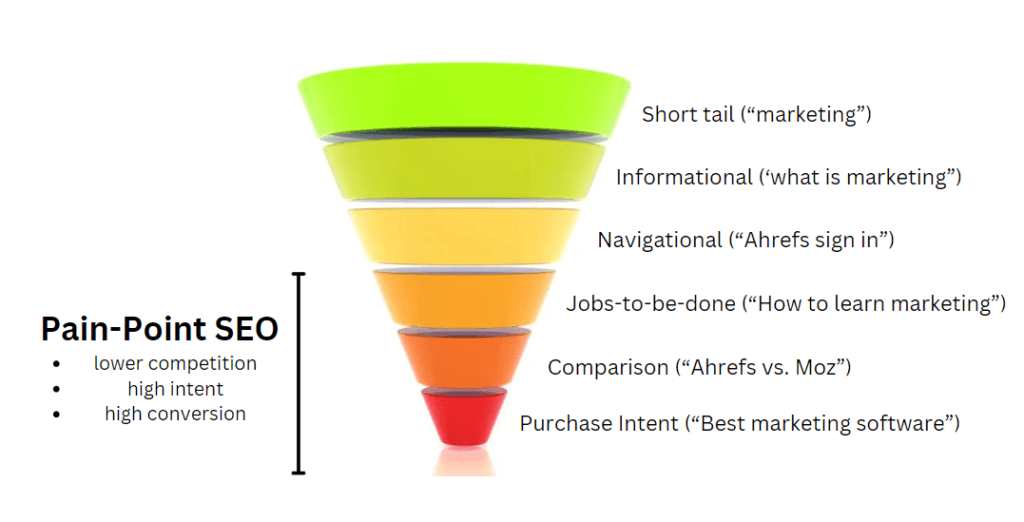How To Get More Sales With Pain-Point SEO (Startups, SaaS, & Small Businesses)
Most business owners signed up for an SEO package hoping to drive lots of search traffic. Some did, but they faced another problem — conversion. Getting search traffic doesn’t automatically guarantee conversion. Furthermore, high-traffic keywords are extremely difficult to rank.
Chances are, you don’t have an unlimited budget to spend on SEO. Therefore, you need to make your SEO campaign count. This means avoiding ‘high traffic’ keywords that may not guarantee leads and sales.
I’m writing this blog post to address small business owners, startups, and SaaS brands. And how pain-point SEO can help you rank on Google faster.
The Typical SEO That Most Small Businesses Practice (and Why It Fails)
According to some SEO experts, ranking web content goes like this.
- Search for a high-volume keyword.
- Create content.
- Publish.
- Wait for the content to rank and bring in tens of thousands of visitors monthly.
If this has been your go-to SEO strategy, you must understand why it will fail.
Competition
A keyword that generates large volumes of traffic is usually very competitive. Let’s take ‘digital marketing’, for example.
While the keyword promises over 37,000 unique visitors per month, it’s dominated by top brands like Investopedia, Mailchimp, and Forbes. You can’t publish a blog post targeting a generic, highly competitive keyword and expect it to rank in months.
SEO doesn’t work that way — except for global brands.
To compete with big brands, you need to have an SEO budget like they do. However, the money they spend on creating content, digital PR, legit link building, and other SEO activities is often beyond a startup’s reach.
Search intent
Another reason why targeting high-competition keywords seldom brings sales is the ambiguous keyword intent. Keywords or search intent are your target audience’s motivation when they type a specific phrase on Google.
Some users seek information but don’t plan to buy. Others might be comparing information before they make a decision. There are also users who are on the verge of buying a product or service.
The question is, you can’t tell what a user’s intention is from a generic or short-tail keyword. For example, a user searching for ‘digital marketing’ might want to know what digital marketing is all about. They could also be searching for digital marketing tips they can practice at home.
So, don’t be surprised if you get dismal conversion even if you’re able to rank for generic keywords.
Time
For smaller companies and startups, you don’t have the luxury of time. You need search visibility, and probably within months. Competing with established sites on generic keywords isn’t going to make that happen.
Generic keywords are dominated by:
- renowned brands that have been around for years.
- or companies that spend years inching their way to the top.
Even with the best SEO strategist on your side, you can’t afford to wait that long before you start getting traffic.
Use pain-point SEO instead
You now know why SEO didn’t work out for small businesses as it did for global brands. To increase your chances of success, use pain point SEO instead.
Pain-point SEO is an approach targeting audiences that have a problem to solve and are willing to pay.
You can think of these audiences as customers frequenting a supermarket. They have already decided that they need to buy groceries. All you need to do is convince them that your product is better.
Another analogy is to compare pain-point SEO to bottom-of-the-funnel (BOFU) marketing. It targets people who are aware of their problem, have the information they need, and long for a solution.
Why pain-point SEO is easier (and faster)
Unlike typical SEO strategy, pain-point SEO focuses on long-tail and commercial-intent keywords. Long-tail keywords are phrases that contain more words. These keywords are less competitive and have clearer intent.
For example, ‘how to learn digital marketing at home for free’ is a long-tail keyword with a strong intent and lesser competition.
The only problem is that the audience might not be willing to pay for your product because they are looking for zero-cost solutions. But that doesn’t stop you from persuading them to offer a free trial of your courses.
Ideally, choose long-tail keywords that have strong purchasing intent. Customers usually want to compare products before buying. So, keywords like these are useful in pain-point SEO.
- Best digital marketing course for beginners.
- Ahrefs SEO tool review.
- Ahref vs. Semrush
- Is Hootsuite worth it
They let you engage with audiences who are at the end of the purchase lifecycle. In other words, they will buy a product, whether they landed on your webpage or not. And your goal is to get them to land of yours.
Also, some of these long-tail BOFU keywords have very little competition. You might be ranking on Google in a few weeks without any link-building or outreach campaign.
For example, I took less than 3 months to rank an article targeting “Smodin AI review’, on this low domain authority (DA) site. Because my website is fairly new, I’ll be struggling to rank for phrases like “AI writing” and “AI tools’. I also avoided them because they lacked clear search intent.
I’m not the only one applying this tactic. Smodin’s competitor, Jenni AI, managed to land on Google Snippet with a similar review.
How to craft a pain-point SEO strategy
If you want faster SEO results that increase conversion, ditch SEO that focuses on generic keywords and switch to pain-point SEO. Here’s how.
Perform keyword research
Start with researching keywords that the audience uses when they want to solve a problem. Make a list of keywords spanning several categories.

Purchase intent keywords
These keywords have the highest conversion intent and typically point to the solution that users seek. For example:
- best yoga pants.
- ahrefs coupon code
- car repair austin texas
People searching for these keywords are keen to spend on fitting solutions.
Comparison keywords.
Like conversion-driven keywords, comparison keywords also target audiences at the bottom of the sales funnel. Before buying, they want to compare a product with competitors’ so they can make an informed decision.
They use phrases that follow a specific structure.
- [Product A] vs. [Product B]
- [Product A] vs. [Product B] vs. [Product C]
- Is [Product A} better than [Product B]
- [Product A] alternative
Compared to pain-point keywords in general, some comparison keywords are less competitive and easier to rank.
Jobs-to-be-done keywords
Jobs-to-be-done (JTBD) keywords are phrases that the audience keys in when they want to solve a problem.
Let’s check out some JTBD keywords.
- How to increase email open rate.
- How to eliminate dust mites.
- How to rank with SEO without link building.
These keywords might not outright indicate an intention to buy, but they present opportunities to recommend your products or services as a solution.
That said, the content should focus on answering the ‘how’ rather than selling products. When done right, you can funnel the audience to a landing or product page and convert them.
Write content
Next, write blogs that provide answers to the search phrases. The key here is to meet the search intent, regardless of the type of keywords. When writing the content, don’t obsess about hitting keyword counts. Rather, try to create the most valuable content you can offer.
For example, your competitor writes an article listing ‘5 tips that help increase email open rate’. You can:
- Broaden the answer by listing more than 5.
- Go deeper by covering details that only seasoned email copywriters know.
- Provide examples with screenshots from your email analytics.
- Include your personal opinion because that adds authority to your content.
Then, use tools like SurferSEO to ensure your article includes some of the important keywords. Remember, don’t force a keyword into an article. If it doesn’t sound natural, it’s better to omit the keyword.
Get more tips on writing SEO content here.
Create topic cluster
Publishing 1-2 articles that target high-intent long-tail keywords won’t get them anywhere near Google’s top search results. That’s because they don’t demonstrate your brand’s authority in the topic. Without a strong topical authority, it’s harder to rank good content.
So, it’s important to build a topic cluster around the pain point keywords. If your pain point keyword is ‘best email marketing software,’ you can create a topic cluster with articles addressing other concerns about email marketing. For example,
- How to write emails to get a higher open rate.
- Top email marketing mistakes to avoid.
- What is email marketing?
- Does email marketing still work?
- How to get started with email marketing.
Some content in the topic cluster doesn’t target a commercial-intent keyword, and that’s ok. The idea is to publish a group of articles that you can interlink with and show Google that you’re an authority on the topic.
How long does it take for pain-point SEO to work?
Some SEOs would tell you, ‘It depends’.
But I can confidently say that you’ll see an increase in search traffic between 6 and 12 months by targeting long-term, commercial-intent keywords. Personally, it took me less than 6 months to rank my first blog with this approach, which gave me my first earnings.
Ranking with pain-point SEO is much faster than a generic strategy. Of course, this also assumes that:
- You create SEO-optimized content.
- You have no issues with technical SEO (page loading speed, SSL, etc.)
- You’re building your brand presence.
- You publish clusters of similar-topic content.
- You adhere to other legit SEO best practices.
Brand presence is important, particularly with Google’s March 2024 algorithm update and its future direction. Google wants to reward businesses that create useful content, not marketers manipulating the search engine to make quick gains.
Final thoughts
The bottom line is you need to stop competing with big brands at their SEO game. Pouring more money to grab top spots for high-traffic keywords that don’t always convert is senseless. Rather, change our SEO strategy and start targeting people who are ready to buy.
To wrap up, pain-point SEO is:
- Targeted
- Easier
- Less competitive.
- More affordable.
- Guarantees higher conversion.
Leave a message here if you need help implementing a high-converting SEO strategy.







